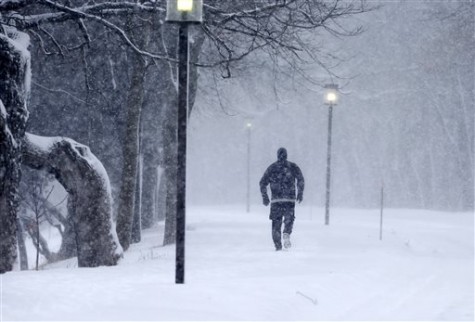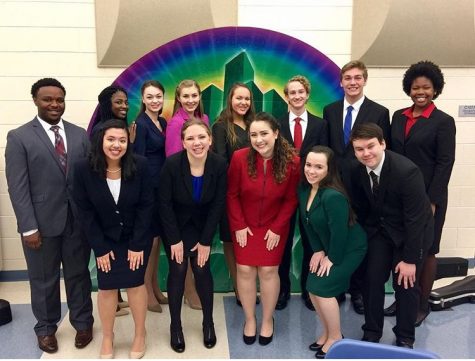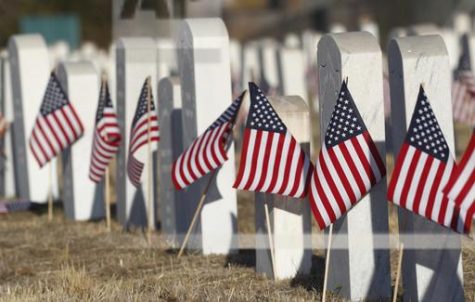Students Mourn Snow Day That Never Was

A car dealership employee cleans off a vehicle, Wednesday, Feb. 3, 2016, following a snowstorm which dumped a foot of snow in Southern Minnesota. (AP Photo/Jim Mone)
Starting last Monday afternoon and continuing through the night into Tuesday morning, southern Minnesota was pummelled with a winter storm. With snow falling at up to 1-2” per hour, metro areas were covered in almost 10” of snowfall.
On Monday morning, before the first hour bell rang, Principal Degenaar came over the loudspeaker to announce that school would be released early, at the end of fourth period. Students cheered and hurriedly texted parents.
Shortly after being released from school, no driver from AVHS could argue with the decision. As light, fluffy flakes fell from the sky, visibility was next to nothing. The roads surrounding the school were packed with students and teachers in a frenzy to get home.

At AVHS, there was only one question on the minds of students and faculty alike: Snow day tomorrow?
The next day, most were expecting at least a delayed start. However, the district surprised many by holding a normal schedule.
“I have a first hour study hall, so the roads were pretty good when I left. But I still slipped around a little bit. And I still wanted a snow day,” said senior Kevin Cranmer.
“Not a fan of students having to drive through that on the way to school, ‘cause high schoolers suck at driving anyways. I’m fine with having school though; I don’t think having it is terrible,” said senior Tony Lee.
Though Principal Degenaar calls the shots at AVHS, he is not involved with weather emergency decisions. “Once the district office makes the decision, I usually get an email or a phone call and then we start spreading the word,” he said.
“I am very glad I do not have to make these decisions that affect 26,000 K-12 graders and their parents and guardians. No matter what the decision is, people will be unhappy,” Principal Degenaar also told me.
Jane Berenz is our District 196 superintendent, who does call the shots on snow days. She looks at a few key factors (the number of students tweeting at her is not one) to decide. The district website states:
“The overriding concern in making the decision to close schools is the safety of our students, staff and others in the community. Beyond that, the process becomes more complicated. The fundamental decision is whether students and staff will be safer with school in session or with school closed for the day. Several factors are considered, including the following:
Road conditions are extremely important and must be considered throughout the 110 square miles that make up our district, including rural areas where blowing snow can severely limit visibility for drivers; school buses can drive through very deep snow, but they can’t make it through to school if intersections are clogged with stuck vehicles.
[…] When severe winter weather occurs, the following steps are taken to examine weather conditions and to decide whether to delay or cancel the opening of school.
By 3:45 a.m., district Transportation Department employees are driving on key roads throughout the district and contacting city and county highway departments to determine if the roads are safe for travel.
By 5 a.m., the Transportation Department coordinator contacts the superintendent with information on weather and road conditions and they discuss whether there may be a need to change the school schedule.”
Superintendent Berenz was unavailable, but I was able to get in contact with Kim Craven, her administrative assistant. Craven gave me a behind-the-scenes look at how Tuesday’s decision was made:
“Superintendent Berenz talked with our transportation coordinator, who was out on the roads early Wednesday morning. The coordinator gave the recommendation that buses would be able to get to school safely. At 110 square miles, this is a large district, and sometimes weather conditions vary from one end to the other. If students or their parents ever feel it is unsafe for the student to get to school, the parent can call the attendance office and have the student excused.”
So, despite some neighborhood roads being unplowed, it was determined that it was safe for students to get to school at their regular time. On top of this, the weather forecast for the rest of Tuesday showed no signs that the storm would return.
Should there have been a snow day after all? No matter how small the chance for one was, the kid in everyone can’t help but feel a little let down.







Josh Johnson • Feb 29, 2016 at 3:17 pm
Someone definitely passed Safety Ed. Scanlon approves!
Ivan • Feb 9, 2016 at 3:26 pm
“If students or their parents ever feel it is unsafe for the student to get to school, the parent can call the attendance office and have the student excused.”
And that is exactly what I did. I woke up, looked outside, and said N O P E. I love farther from the school than most students because I came from Burnsville out of district. The roads were unplowed, there was ice hidden, and cars were slipping. If ever you feel your safety on the roads would be compromised in a situation like this I definitely recommend talking to your parents about calling in absent. Always consider your safety first over your obligation to attend school.